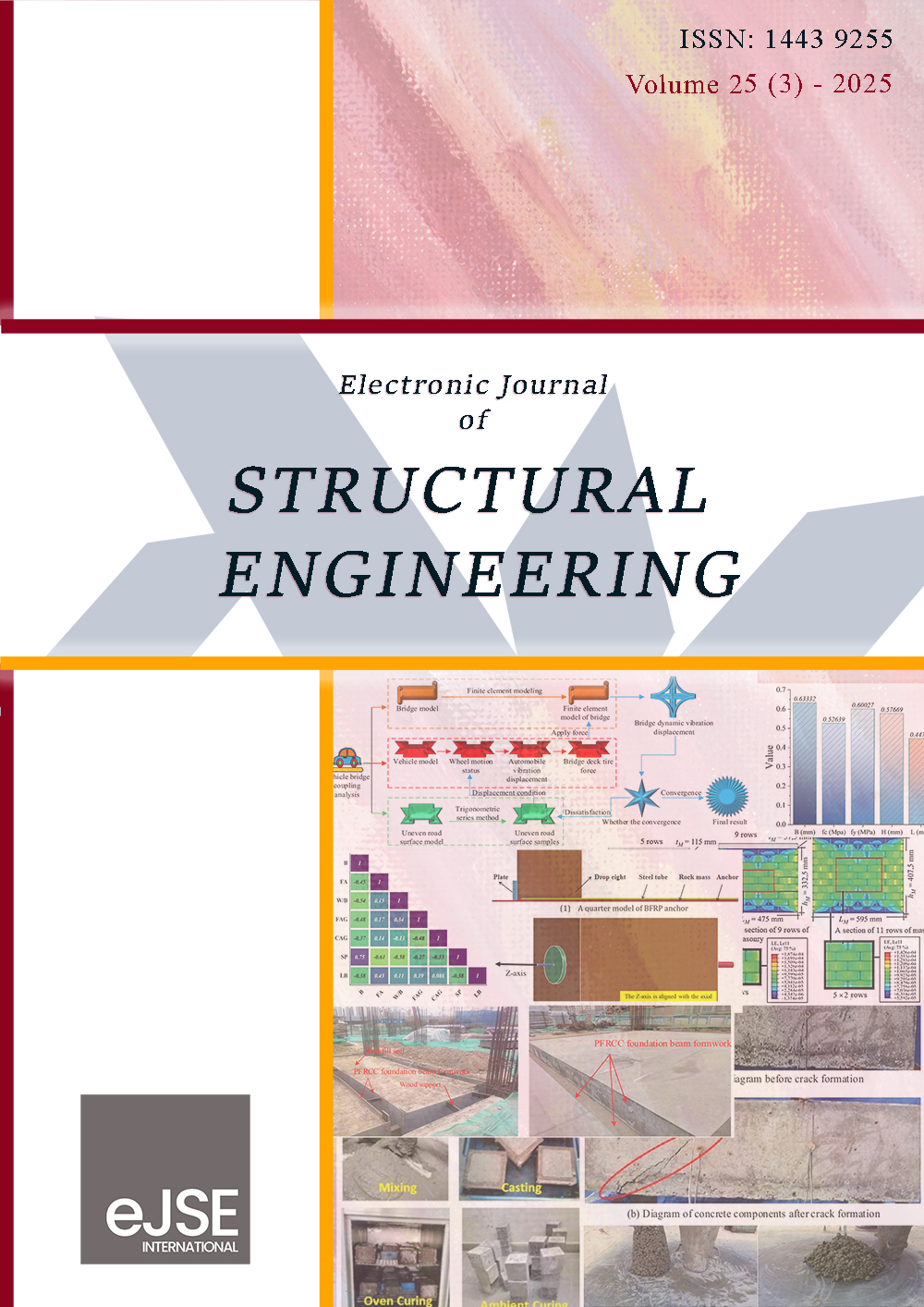Investigation of Plant Fiber-Reinforced Cementitious Composites for Permanent Formwork in Foundation Beams
DOI:
https://doi.org/10.56748/ejse.24787Keywords:
PFRCC, Foundation beam, Permanent formwork, Three-point bending tests, Green buildingAbstract
This paper aims to solve the problems of extensive labor input and long construction periods of traditional foundation beam brick formwork. We propose using plant fiber-reinforced cementitious composites (PFRCC) panels instead of conventional foundation beam brick formwork. This study conducted tests and finite element analyses on the PFRCC panels employed as permanent formwork for foundation beams, based on a construction project in a community in Lanzhou City, Gansu Province, China. The results indicate that the maximum bending stress of the PFRCC panels utilized as permanent formwork for foundation beams is 0.4069 MPa, occurring at the junction between the side and bottom forms, which is significantly lower than the specified design strength of 13.7 MPa. Furthermore, the maximum deformation recorded was 1.528 mm at the mid-span of the side template, remaining below the permissible limit of 2.5 mm. The bending strength and stiffness deformation meet the design requirements, which shows that the PFRCC panels can be used as the permanent formwork of the foundation beam.
Downloads
References
Arslan, M., Şimşek, O., Subaşı, S. (2005). Effects of formwork surface materials on concrete lateral pressure. Construction and building materials, 19(4), 319-325.
Conforti, A., Zerbino, R., Plizzari, G. A. (2019). Influence of steel, glass and polymer fibers on the cracking behavior of reinforced concrete beams under flexure. Structural Concrete, 20(1), 133-143.
Empelmann, M., Oettel, V., Cramer, J. (2020). Berechnung der Rissbreite von mit Stahlfasern und Betonstahl bewehrten Betonbauteilen. Beton‐und Stahlbetonbau, 115(2), 136-145.
Geng, J., Cheng, W., & Liu, G. (2024). Enhancing interface shear performance and bending resistance of UHPC permanent formwork for composite short beams by different interface treatment. Journal of Building Engineering, 85, 108736.
Guo, Y. H.,Li, L., Yang, C. X.,Shi, Y. Q. (2022). Research progress of plant fiber reinforced concrete. Bulletin of the Chinese Ceramic Society, 41(10), 3347-3358.
Haido, J. H. (2020). Flexural behavior of basalt fiber reinforced concrete beams: Finite element simulation with new constitutive relationships. Structures, 27, 1876-1889.
Hemmatian, A., Jalali, M., Naderpour, H., & Nehdi, M. L. (2023). Machine learning prediction of fiber pull-out and bond-slip in fiber-reinforced cementitious composites. Journal of Building Engineering, 63, 105474.
Huang, B. T., Li, Q. H., Xu, S. L., Li, C. F. (2017). Development of reinforced ultra-high toughness cementitious composite permanent formwork: experimental study and digital image correlation analysis. Composite Structures, 180, 892-903.
Hall, J. E., Mottram, J. T. (1998). Combined FRP reinforcement and permanent formwork for concrete members. Journal of Composites for Construction, 2(2), 78-86.
Keskisaari, A., Butylina, S., Kärki, T. (2016). Use of construction and demolition wastes as mineral fillers in hybrid wood-polymer composites. Journal of Applied Polymer Science, 133(19).
Kochova, K., Gauvin, F., Schollbach, K., & Brouwers, H. J. H. (2020). Using alternative waste coir fibres as a reinforcement in cement-fibre composites. Construction and Building Materials, 231, 117121.
Kim, G. B., Pilakoutas, K., Waldron, P. (2008). Development of thin FRP reinforced GFRC permanent formwork systems. Construction and building materials, 22(11), 2250-2259.
Li, V. C. (1993). From micromechanics to structural engineering the design of cementitious composites for civil engineering applications. Doboku Gakkai Ronbunshu, 10(2), 37-48.
Leblouba, M., Altoubat, S., Karzad, A. S., Maalej, M., Barakat, S., & Metawa, A. (2022). Impact response and endurance of unreinforced masonry walls strengthened with cement-based composites. Structures, 36, 262-279.
Li, Q. H, Gao, X., Xu, S. L., Zhao, X. (2015). Permanent formwork of ultra-high toughness cementitious composites added with nano-SiO2. China civil engineering journal, 48(06), 9-16.
Li, M., Khelifa, M., Khennane, A., El Ganaoui, M. (2019). Structural response of cement-bonded wood composite panels as permanent formwork. Composite Structures, 209, 13-22.
Li, W., Wang, Z., Li, L., Du, T., & Sun, L. (2023). Experimental study on axial compression of hybrid fiber cement-based composite column with circular cross section. Structures, 53, 664-676.
Ministry of Housing and Urban-Rural Development of the People's Republic of China. (2012). Code for construction of concrete structures (GB 506666-2011). China Architecture & Building Press, Beijing.
Meng, W., Khayat, K. H. (2016). Experimental and numerical studies on flexural behavior of ultrahigh-performance concrete panels reinforced with embedded glass fiber-reinforced polymer grids. Transportation Research Record, 2592(1), 38-44.
Oettel, V. (2023). Steel fiber reinforced RC beams in pure torsion-Load‐bearing behavior and modified space truss model. Structural Concrete, 24(1), 1348-1363.
Oettel, V., Schulz, M., Haist, M. (2022). Empirical approach for the residual flexural tensile strength of steel fiber‐reinforced concrete based on notched three‐point bending tests. Structural Concrete, 23(2), 993-1004.
Prosk, T., Khayat, K. H., Omran, A., Leitzbach, O. (2014). From pressure generated by fresh concrete: a review about practice in formwork design. Materials and structures, 47(7), 1099-1113.
Puente, I., Santilli, A., Lopez, A. (2010). Lateral pressure over formwork on large dimension concrete blocks. Engineering Structures, 32(1), 195-206.
Standardization Administration of China. (2014). Test methods for fiber cement products (GB/T 7019-2014). Standards Press of China, Beijing.
Tiberti, G., Germano, F., Mudadu, A., Plizzari, G. A. (2018). An overview of the flexural post‐cracking behavior of steel fiber reinforced concrete. Structural Concrete 19(3), 695-718.
Turku, I., Keskisaari, A., Kärki, T., Puurtinen, A., Marttila, P. (2017). Characterization of wood plastic composites manufactured from recycled plastic blends. Composite Structures, 161, 469-476.
Tian, H., Zhou, Z., Zhang, Y., & Wei, Y. (2020). Axial behavior of reinforced concrete columns with ultra-high performance concrete stay-in-place formwork. Engineering Structures, 210, 110403.
Väntsi, O., Kärki, T. (2014). Utilization of recycled mineral wool as filler in wood-polypropylene composites. Construction and Building Materials, 55, 220-226.
Wang, X., Liu, H., Ju, Y., & Wang, D. (2021). Experimental and analytical models of flexural behavior of U-shaped reactive powder concrete permanent beam formworks. Construction and Building Materials, 300, 123670.
Wang, L. H., Shi, W. H., Qian, L. P., Bai, Y. L., Liu, S. Z., & Yang, Z. Q. (2025). Flexural behaviors of GFRP-reinforced Engineered Cementitious Composite (ECC)-concrete composite beams. Engineering Structures, 332, 120097.
Zhang, W., Huang, J., Li, Z., Huang, C. (2016). An experimental study on the lateral pressure of fresh concrete in formwork. Construction and building materials, 111, 450-460.
Downloads
Published
How to Cite
Issue
Section
License
Copyright (c) 2025 Xinyuan Wang, Ping Li, Xuansheng Cheng, Mei Lin, Shunli Ma, Xufeng Du

This work is licensed under a Creative Commons Attribution 4.0 International License.







